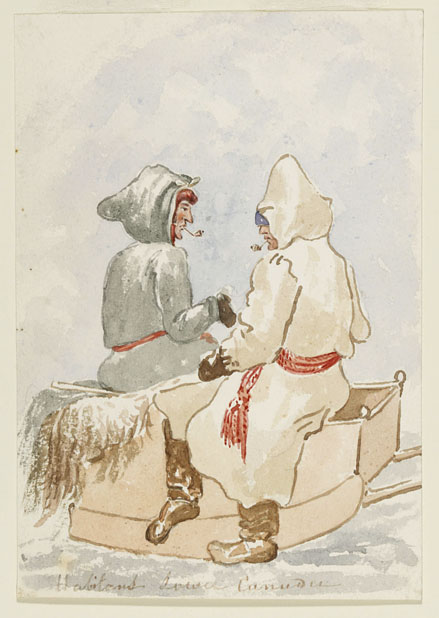Habitants, Bas-Canada, Date inconnue, John Crawford Young, Musée royal de l’Ontario (Toronto), 957.63.5.
Courtoisie du Musée royal de l’Ontario, ©ROM.

Habitants, Bas-Canada, Date inconnue, John Crawford Young, Musée royal de l’Ontario (Toronto), 957.63.5.
Courtoisie du Musée royal de l’Ontario, ©ROM.
Habitants, Lower Canada, Date Unknown, John Crawford Young, ROM: Royal Ontario Museum (Toronto), 957.63.5.
Courtesy of the Royal Ontario Museum, ©ROM.


En Amérique du Nord, de la fin de XVIIe siècle jusqu’au milieu du XIXe siècle, un « voyageur » est un employé d’une compagnie ou un aventurier qui part faire la traite des fourrures avec les Amérindiens. Le dessin de John Crawford Yong (1788-1859), ici, fait plutôt référence à une personne qui voyage.
L’illustration nous montre deux personnages qui portent une ceinture fléchée et sont revêtus d’un manteau fabriqué avec de la laine et du lin, communément appelé « étoffe du pays ». La présence d’une femme laisse croire que le voyage n’en n’est pas un vers l’aventure dans les bois et les lointaines plaines canadiennes.
Le terme « Voyageur » est utilisé pour désigner divers lieux ou institutions en Ontario. Près de Chute-à-Blondeau, dans l’Est ontarien, il y a le Parc provincial Voyageurs; à Sudbury, l’hebdomadaire francophone s’appelle Le Voyageur; à Ottawa, il y a une l’École élémentaire catholique des Voyageurs et le festival Mattawa Voyageur Days a lieu en juillet.
In North America, from the late 17th century to the mid-19th century, a “voyageur” (traveller) was an employee of a company or an adventurer who took part in the fur trade with Amerindians. The drawing of John Crawford Young (1788-1859) here refers instead to a person who travels.
The two illustrated figures in the foreground wear an arrowhead sash and are dressed in wool and linen coats, commonly known as “homespun”. The presence of a woman suggests that the journey is not one of adventure in the distant Canadian forests and prairies.
The term “voyageur” is used to denote different places or institutions in Ontario. Near Chute-à-Blondeau, in Eastern Ontario, there is Voyageur Provincial Park; in Sudbury, the French-language weekly is called Le Voyageur; in Ottawa, there is an École élémentaire catholique des Voyageurs (“Voyageurs Catholic Elementary School”) and Mattawa Voyageur Days festival takes place every year in July.
Paul François Sylvestre
Source
The Royal Ontario Museum (ROM) is the only multidisciplinary museum in Canada that includes natural history, art, and archaeology. The ROM is also one of the leading provincial institutions that is still active within scientific and archaeological research around the world. It is home to an internationally celebrated collection that explores a large variety of subjects through its diverse museum programs, galleries, and exhibitions. Visitors can participate in a variety of family and children’s programming, adult workshops, tours, conferences, and hands-on activities. The museum also offers an interactive web site, and public access to their research library.
Info: 100 Queen’s Park, Toronto, ON, M5S 2C6
Tel: 416-586 -8000
www.rom.on.ca